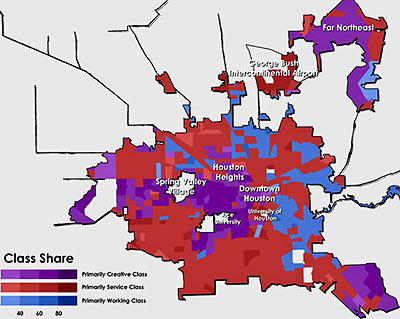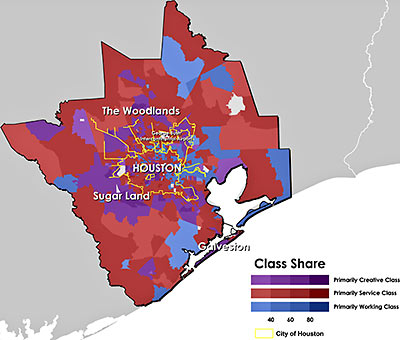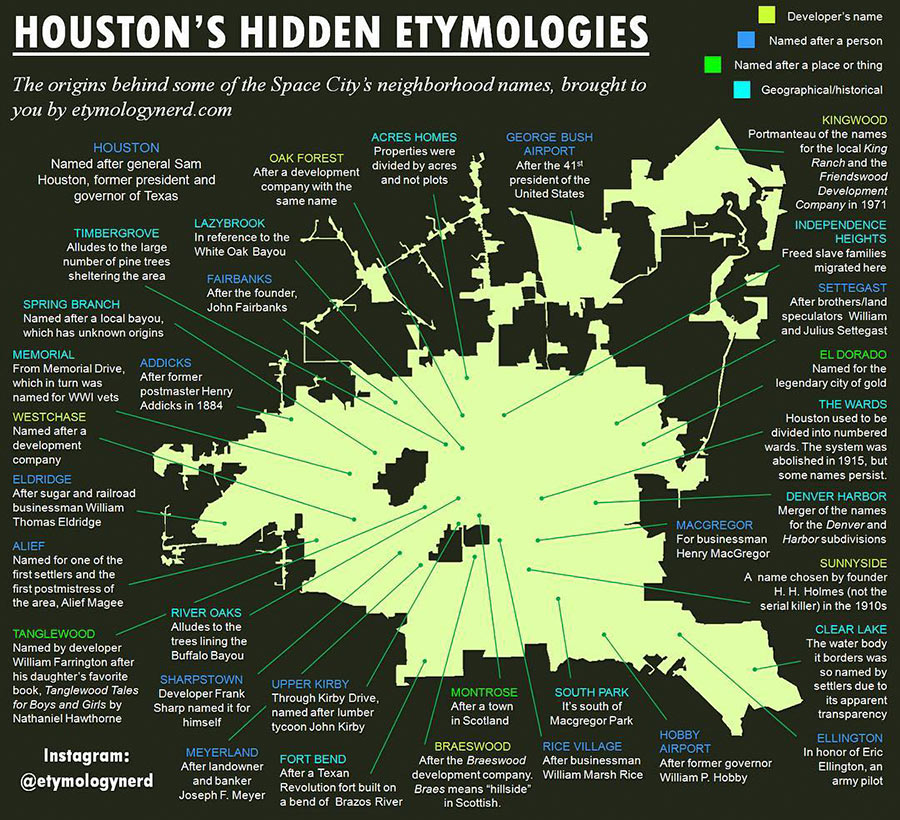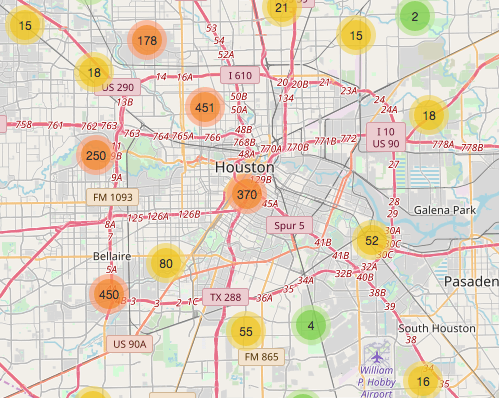
This map from Rise of the Creative Class author Richard Florida’s series at The Atlantic on “class-divided cities” shows where Houston’s working, service, and creative classes live.
Denoted here in purple, what Florida considers the creative class — that is, he writes, “people who work in science and technology, business and management, arts and culture, media and entertainment, and law and healthcare professions” — makes up 33 percent of Houston’s workers; that’s just a little bit larger than the national average, according to Florida, of 32.6 percent.
And what about the service and working classes?
***
According to Florida, Houston’s service class — that is, “low-wage, low-skill occupations in the service sector, such as food service and preparation, retail sales, and clerical and administrative positions” — is substantially smaller at 42.5 percent than the 46.6 percent national average.
And the working class? That’s substantially larger here: 24.4 percent compared with 20.5 percent.
Florida adds:
One striking feature of Houston’s class geography is the relatively large number of working class areas that remain in the city proper. Not only does this stand in sharp contrast to post-industrial cities like Washington, D.C., but also compared to once heavy manufacturing cities like Detroit, Philadelphia, and Boston. Houston has by far the largest number of concentrated urban working class enclaves of any city covered in this series. This reflects the region’s history as a center for the petroleum, petrochemical and related industries, as well as blue-collar activity around Port of Houston, one of the nation’s busiest.
The map below shows the class geography of the metro area:

- Class-Divided Cities: Houston Edition [The Atlantic Cities]
Maps: Zara Matheson





I guess you’d have to be primarily creative class to live in the Barker reservoir.
Interesting that 7/10 of the “Creative Class” locations are around Rice/Braeswood/Astrodome/West U. Seems developers would take notice and develop more along South Main (south of Old Spanish Trail towards 610). The car washes, $20 parking lots, and rundown remaining 2-story apartments seem like a wasted opportunity.
The zoom in map quickly shows some problems with this. Someone didn’t do their research on the big red chunk of Shepherd Park/Candlelight/Ella Lee Forest on here. Or only the poor people mailed in their census forms. You can’t buy anything in that section that isn’t a total gut job for under $300k anymore. Primarily low wage Service Class? Maybe 10-15 years ago. Now? I think not.
@ Spoonman
“I guess you’d have to be primarily creative class to live in the Barker reservoir.”
———
But not nearly as creative as you’d have to be to live in the middle of Lake Houston.
EADO IS PURPLE. No wonder there is so much development happening.
And here I was with the un-PC thought that if you overlaid this with either a political map or a map by race/ethnicity, you’d see a whole bunch of similarities.
“Creative class” has to be the most obnoxious euphemism for bourgeoisie I have yet encountered. Even David Brooks BoBo is better.
What is wrong with Bourgeois? It just means town-dweller. Personally I come from a long line of petit-bourgeoisie, I am a proud bourgeois.
What Florida has done is to create an index of the predictors of wealth. He then wrote and marketed books that target those populations as consumers of information, and especially pseudo-information about themselves.
It’s not very, uhmmm…useful.
Not to be outdone, respected companies like Pitney Bowes have developed ‘psychographic’ indices that break out several dozen different types of households from the Census data according to cute names and cartoon depictions. It seems to pass muster in the realm of marketing and advertising, but its a very superficial approach aimed at people that would qualify as being employed in a “creative” function but that are in fact very unimaginative and dull.
Comparing Texas to Florida is rather pointless. Though then again that state was also stupid enough to elect a Bush too. I found this interesting, albeit heavy handed in it’s approach to demographics.
CM wins for the best troll comment!
cm, the author’s name is Richard Florida. He was referring to the author, not the state.
@cm pretty sure nobody compared Texas to Florida
TheNiche’s is Comment of the Day. Whether it’s selected or not, it’s still Comment of the Day.
Richard Florida cannot possibly know whether I’m in a creative industry simply from Census data. I would guess that I got counted as the creative class in his “study”, but if he found out my industry, I’m sure I’d be considered the “wrong kind of creative class” (to paraphrase SWPL).